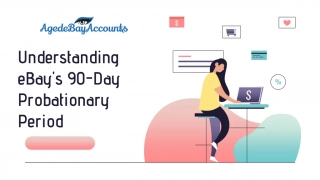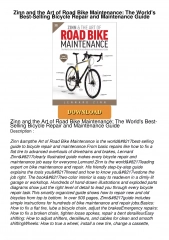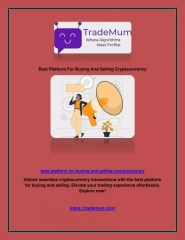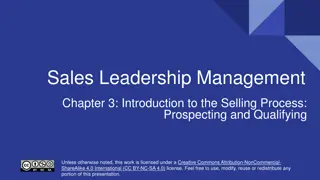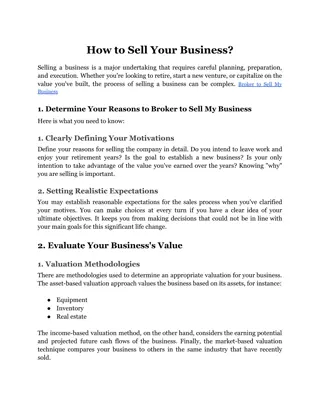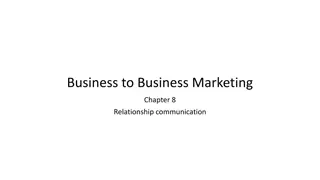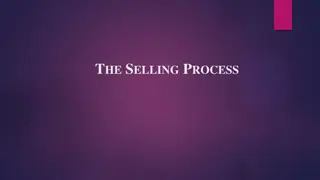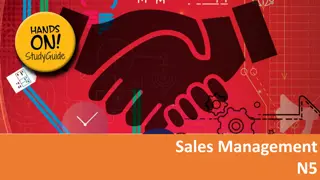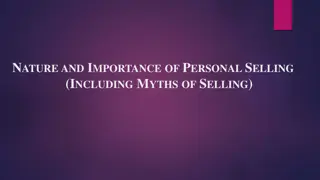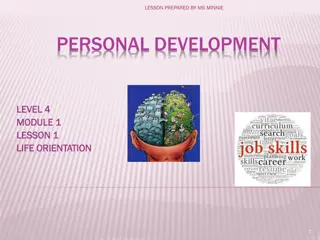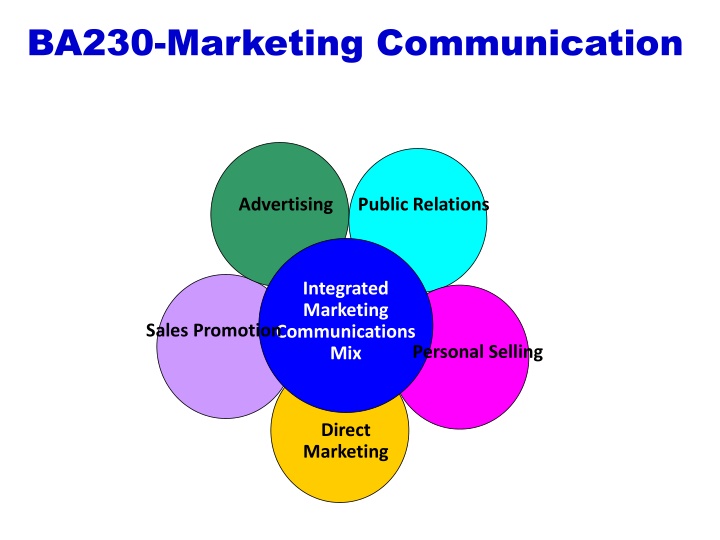
Personal Selling in Marketing Communication
Explore the concept of personal selling in marketing communication, its role in persuading customers, and the essential skills and qualifications required for successful salespeople. Learn about the duties, responsibilities, and importance of the sales force in building customer relationships and driving company profits.
Download Presentation

Please find below an Image/Link to download the presentation.
The content on the website is provided AS IS for your information and personal use only. It may not be sold, licensed, or shared on other websites without obtaining consent from the author. If you encounter any issues during the download, it is possible that the publisher has removed the file from their server.
You are allowed to download the files provided on this website for personal or commercial use, subject to the condition that they are used lawfully. All files are the property of their respective owners.
The content on the website is provided AS IS for your information and personal use only. It may not be sold, licensed, or shared on other websites without obtaining consent from the author.
E N D
Presentation Transcript
BA230-Marketing Communication Advertising Public Relations Integrated Marketing Communications Mix Sales Promotion Personal Selling Direct Marketing
Personal Selling Person-to-person interactive communication used to ultimately persuade a current/prospective customer to buy something The Oldest Marketing Communication Function # potential customers decrease Complexity of product increases Value of the product grows
Personal Selling Involves two-way, Personal communication between salespeople and individual customers whether: face to face, by telephone, through video conferencing, or by other means.
Salesperson / people An individual acting for a company by performing one or more of the following activities: prospecting, communicating, servicing, and information gathering. Salespeople have many names Sales Engineers District Managers Marketing Representatives Account Development Representatives Agents Sales consultants Sales Representatives Account Executives
Duties/Responsibilities: selling, service, prospecting, presentations, pricing quotes, terms, orders, marketing research, advising, study, travel, meetings, paperwork. Satisfied customers repeat their purchases because they are satisfied with the value of the relationship Taking care of existing customers reduces sales cycle time and increases efficiency
The Role of the Sales Force Sales force serves as critical link between company and its customers. They represent the company to the customers. They represent the customers to the company. Goal = customer satisfaction and company profit.
Qualifications And Skills Required For Success By Salespeople Empathy: To see things as others would see them Ego Drive: Determination to achieve goals Ego Strength: Self-assured and self-accepting Interpersonal Communication Skills: Including listening and questioning Enthusiasm: In general, and for sales as a career Customer Orientation Use of Truthful and Nonmanipulative Tactics Focus on Long-Term Satisfaction of Customer and Selling Firm Understand general business and economic trends, Provide guidance throughout the sales process Help the buyer to solve problems Have a pleasant personality and a good professional image
The Four Sales Channels Personal selling occurs through several types of communication channels including these four: Over-the-Counter Field Selling Telemarketing Inside Selling
Disadvantages Advantages Build, maintain and enhance interactions with customers to develop long-term satisfaction through mutually beneficial partnerships More than just a transaction or one-time sale Detailed explanation/demonstration of product Sales message can be varied according to motivations/interests of prospect; can respond to objections Directed only to qualified prospects Costs can be controlled by adjusting size of sales force in one-person increments More effective in gaining a sale! Can not reach mass audience Expensive per contact Numerous calls needed to generate sale Labor intensive
How salespeople spend their time Face-to-Face Selling 33% Account Service Coordination Phone Selling 16% 16% Internal Meetings Administration Travel 10% 5% 20% SOURCE: William A. O Connell and William Keenan, Jr., The Shape of Things to Come, Sales & Marketing Management, January 1990, pp. 36-41.
The Sales Process Prospecting & qualifying Pre- Presentation & demonstration Approach approach Learn as much as possible about customer Identify qualified potential customers Make a relationship Tell the product story & focus on customer benefits Handling objections To insure customer satisfaction & repeat business Closing Follow-up Overcome customer objections Ask for an order
The Sales Process The AIDA Concept and the Personal Selling Process
Step 1. Prospecting & Qualifying P: Salesperson identifies potential customers. Developing lists of potential customers Q: Process of identifying good prospects Finding and analyzing information about prospects Evaluating a prospect s potential
Step 2. Preapproach Salesperson learns as much as possible about a prospective customer before making a sales call.
Step 3. Approach Salesperson meets the buyer and gets the relationship off to a good start. HOW DO WE MAKE THE INITIAL CONTACT & BUILD RAPPORT There is only one time to make a first impression
Step 4. Presentation & Demonstration Salesperson tells the product story to the buyer using the need-satisfaction approach. Making the sales presentation Using persuasive communication Hold attention Stimulate interest Desire Tell the product s story
Step 5. Handling Objections Salesperson seeks out, clarifies, and overcomes customer objections to buying. Questions Reservations Understand Concern Counterarguments Acknowledge concern Clues to process
Step 6. Closing the Sale Determining the terms of the transaction and getting the prospects agreement to those terms. Salesperson asks the customer for an order. Closing signals Trial close Asking the prospect to buy
Step 7. Following Up Occurs after the sale and ensures customer satisfaction and repeat business. Commitments met Shipment Performance Satisfied customers rebuy & recommend Supporting the buying decision Managing implementation Dealing with dissatisfaction Enhancing the relationship
Sales (Force) Management Activities of planning, organizing, staffing, motivating compensating, and evaluating and controlling a sales force to ensure its effectiveness The analysis, planning, implementation, and control of sales force activities.
Major Steps in Sales Force Management Designing Salesforce Strategy and Structure Recruiting and Selecting Salespeople Training Salespeople Compensating Salespeople Supervising Salespeople Motivating Salespeople Evaluating Salespeople
1. Designing Sales Force Strategy and Structure Territorial Complex Forms Are a Combination of Any Types of Sales Force Structures Exclusive Territory to Sell the Company s Full Product Line Product Sales Force Sells Only a Portion of The Company s Products or Lines Customer Sales Force Sells Only to Certain Customers or Industries
Other Sales Force Strategy and Structure Issues Outside Sales Force Inside Sales Force Conduct Business From Their Offices Via Phone or Buyer Visits Travel to Call on Customers Tele- Technical Support People Finds Major New Prospects Marketing Or Internet Sales Assistants Sells to Major Accounts
2. Recruiting and Selecting Salespeople Recruiting involves: Soliciting applications Screening candidates Interviews Sales aptitude, personality, analytical and/or organizational tests References, work history, etc. Careful recruiting can: Increase overall sales force performance Reduce turnover Reduce recruiting and training costs
3. Training Salespeople Average training period is 4 months Training is expensive, but yields strong returns Many companies are adding Web-based sales training programs Training programs have many goals: Learn about different types of customers and their needs, buying motives, and buying habits. Learn how to make effective sales presentations. Learn about and identify with the company, its products and its competitors.
4. Compensating Salespeople To Attract Salespeople, a Company Must Have an Attractive Plan Made Up of Several Elements Expense Allowance Variable Amount Fringe Benefits Fixed Amount Vacations, sick leave, pension, etc. For Job Related Expenses Usually Commissions or Bonuses Usually a Salary
5. Supervising Salespeople Goal of supervision is to encourage salespeople to work smart. Effective supervisors provide direction to the sales force Help them identify customers & set call norms Develop prospect target Use sales time efficiently Annual Call Plan Time-and-Duty Analysis Sales Force Automation
6. Motivating Salespeople Goal of motivating sales force is to encourage salespeople to work hard Organizational Climate Sales Quotas Positive Incentives Sales Meetings Sales Contests Honors and Trips Merchandise/ Cash awards, trips, profit sharing
7. Evaluating Salespeople Management gets information about its salespeople in several ways: Sales reports, call reports, expense reports, and Personal observations, customer surveys, etc. Formal evaluation of performance can be done qualitatively or quantitatively. Evaluation methods of performance include: Comparing salespeople s performance to others, Comparing current sales with past sales.
Final Note: The critical balance of personal sales: It s the most costly way to reach customers It has the most powerful one-on-one impact

